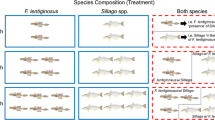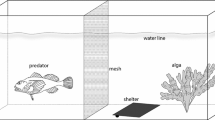Abstract
In many benthic communities predators play a crucialrole in the population dynamics of their prey. Surfacecharacteristics of the prey are important forrecognition and handling by the predator. Because theestablishment of an epibiotic assemblage on thesurface of a basibiont species creates a new interfacebetween the epibiotized organism and its environment,we hypothesised that epibiosis should have an impacton consumer–prey interactions. In separateinvestigations, we assessed how epibionts onmacroalgae affected the susceptibility of the latterto herbivory by the urchin Arbacia punctulataand how epibionts on the blue mussel Mytilusedulis affected its susceptibility to predation bythe shore crab Carcinus maenas.Some epibionts strongly affected consumer feedingbehavior. When epibionts were more attractive thantheir host, consumer pressure increased. Whenepibionts were less attractive than their host or whenthey were repellent, consumer pressure decreased. Insystems that are controlled from the top-down,epibiosis can strongly influence community dynamics.For the Carcinus/Mytilus system that westudied, the in situ distribution of epibiontson mussels reflected the epibiosis-determinedpreferences of the predator. Both direct and indirecteffects are involved in determining theseepibiont-prey–consumer interactions.
Similar content being viewed by others
References
Atsatt, P. R. & D. J. O’Dowd, 1976. Plant defense guilds. Science 193: 24–29.
Bach, C. E., 1980. Effects of plant diversity and time of colonization on a herbivore–plant interaction. Oecologia 44: 319–326.
Barkai, A. & C. McQuaid, 1988. Predator-prey role reversal in a marine benthic ecosystem. Science 242: 62–64.
Bernstein, B. B. & N. Jung, 1979. Selective pressure and coevolution in a kelp canopy community in Southern California. Ecol. Monogr. 493: 335–355.
Connell, J. H. & R. O. Slatyer, 1977. Mechanisms of succession in natural communities and their role in community stability and organization. Am. Nat. 111: 1119–1144.
Cronin, G. & M. E. Hay, 1996. Susceptibility to herbivores depends on recent history of both the plant and animal. Ecology 77: 1531–1543.
Feifarek, B. P., 1987. Spines and epibionts as antipredator defenses in the thorny oyster Spondylus americanusHermann. J. exp. mar. Biol. Ecol. 105: 39–56.
Gil-Turnes, M. S., M. E. Hay & W. Fenical, 1989. Symbiotic marine bacteria chemically defend crustacean embryos from a pathogenic fungus. Science 246: 116–118.
Hay, M. E., 1986. Associational plant defenses and the maintenance of species diversity: turning competitors into accomplices. Am. Nat. 128: 617–641.
Lampert, W. & U. Sommer, 1993. Limnoökologie. Georg Thieme Verlag Stuttgart, New York, 440 pp.
Littler, M. M, P. R. Taylor & D. S. Littler, 1986. Plant defense associations in the marine environment. Coral Reefs 5: 63–71.
Menge, B., 1995. Indirect effects in marine rocky intertidal interaction webs: patterns and importance. Ecol. Monogr. 65: 21–74.
Menge, B. & J. P. Sutherland, 1987. Community regulation: variation in disturbance, competition, and predation in relation to environmental stress and recruitment. Am. Nat. 130: 730–757.
Pfister, C. A. & M. E. Hay, 1988. Associational plant refuges: convergent patterns inmarine and terrestrial communities result from differing mechanisms. Oecologia 77: 118–129.
Prescott, R. C., 1990. Sources of predatory mortality in the bay scallop Argopecten irradiance(Lamarck): interactions with seagrass and epibiotic coverage. J. exp. mar. Biol. Ecol. 144: 63–83.
Root, R. B., 1973. Organization of a plant-arthropod association in simple and divers habitats: the fauna of collards (Brassica oleracea). Ecol. Monogr. 431: 95–120.
Ryland, J. S., 1976. Physiology and ecology of marine bryozoans. Adv. mar. Biol. 14: 285–443.
Schmidt, M. & W. Gnatzy, 1987. Contact chemoreceptors on the walking legs of the shore crab, Carcinus maenas. Ann. N.Y. Acad. Sci. 1987: 589–590.
Schmitt, R. J., 1987. Indirect interactions between prey: apparent competition, predator aggregation, and habitat segregation. Ecology 68: 1887–1897.
Sommer, U., 1995. An experimental test of the Intermediate Disturbance Hypothesis using cultures of marine plankton. Limnol. Oceanogr. 40: 1271–1277.
Sousa, W. P., 1979. Experimental investigations of disturbance and ecological succesion in a rocky intertidal community. Ecol. Monogr. 49: 227–254.
Threlkeld, S. T., D. A. Chiavelli & R. L. Willey, 1993. The organization of zooplankton epibiont communities. Trends Ecol. Evol. 8: 317–321.
Wahl, M., 1989. Marine epibiosis. I. Fouling and antifouling: some basic aspects. Mar. Ecol. Progr. Ser. 58: 175–189.
Wahl M. (in press). Living attached: aufwuchs, fouling, epibiosis. In Nagabhushanam, R. & M. F. Thompson (eds), Fouling Organisms of the Indian Ocean: Biology and Control Technology. Oxford & IBH Publ. Co. Put Ltd, New Delhi: 31–83.
Wahl, M. & M. E. Hay, 1995. Associational resistance and shared doom: effects of epibiosis on herbivory. Oecologia 102: 329–340.
Wootton, J. T., 1993. Indirect effects and habitat use in an intertidal community: interaction chains and interaction modifications. Am. Nat. 141: 71–88.
Zimmer-Faust, R. K., C. M. Finelli, N. D. Pentcheff & D. S Wethey, 1995. Odor plumes and animal navigation in turbulent water flow: a field study. Biol. Bull. 188: 111–116.
Author information
Authors and Affiliations
Rights and permissions
About this article
Cite this article
Wahl, M., Hay, M.E. & Enderlein, P. Effects of epibiosis on consumer–prey interactions. Hydrobiologia 355, 49–59 (1997). https://doi.org/10.1023/A:1003054802699
Issue Date:
DOI: https://doi.org/10.1023/A:1003054802699




